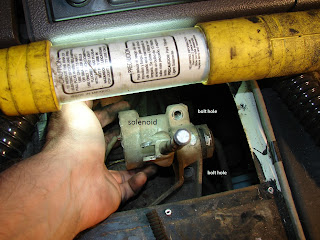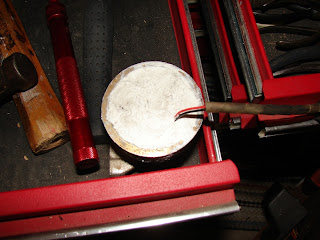 On Saturday I just so happened to find myself at JagGuy’s shop in OKC. The place was a flurry of activity. JagGuy had a tire service over to break down 10 of his M35 tires. It reminded me of my days in the Marine Corps as an ammo truck driver/artilleryman. These are the split rim design and are a real bear to break down when they have sat unused. The rust really builds up. If you don’t think rust affects rubber I challenge you to break down one these tires. Rust is brutal. A mountain of a fellow showed up and over the course of a few hours had them broke down using a tire sledge and two pry bars. Serious hard work.
On Saturday I just so happened to find myself at JagGuy’s shop in OKC. The place was a flurry of activity. JagGuy had a tire service over to break down 10 of his M35 tires. It reminded me of my days in the Marine Corps as an ammo truck driver/artilleryman. These are the split rim design and are a real bear to break down when they have sat unused. The rust really builds up. If you don’t think rust affects rubber I challenge you to break down one these tires. Rust is brutal. A mountain of a fellow showed up and over the course of a few hours had them broke down using a tire sledge and two pry bars. Serious hard work.
As I have mentioned before, JagGuy is buying the surplus M35 trucks and then effectively bobbing them. He is starting to really get them looking good. His partner in crime Rogers was also busy with Jaguar club stuff and had people in and out as well.
And Rogers’s son Bennett had his 1987 Range Rover there. It was having idling problems and just generally not running well. He has nearly replaced the entire ignition system in his quest to get her running well. He mentioned his air idler valve and how he had replaced it. But he was still having idle issues.
So I asked him if he cleaned the seat for the valve? He had not. So we broke out a shop towel and a Phillips head screwdriver and got it cleaned. Immediate positive results. That is how auto repairs are supposed to work. He did have a bit of a knock from the engine. I’m hoping its just bad gasoline and not something more serious.
Bennett has been doing a bang up job getting his Range Rover running. He still has quite a few projects, like most Rovers of that age and use. Like mine, he will have to repair the air conditioning system before the heat of summer makes driving an un-air conditioned car unpleasant. And a new exhaust would be a good idea as well.
JagGuy’s stepson’s Range Rover is down as well. This was formerly JagGuy’s Rangie and he gave it to Brent. It needs an alternator. It also needs some TLC but it is unlikely that Brent will be able to give it to the old girl. Like so many kids his age, cars are magic boxes with wheels that you get in and they take you places.
Only a few kids today know how their cars work, let alone work on them. I often wonder if I taught my kids enough about their cars. I know they claim to know more about how it works than I taught them. This is probably just a defense mechanism, as they don’t want their dad telling them boring stories about how cars work and how to work on them.
I was talking to a young kid just the other day about the usefulness of good old fashioned bailing wire. My youngest daughter listened for about 30 seconds, and mid sentence she said, “Fascinating, truly fascinating dad.” and got up and walked out of the room.
When I was a kid in Newcastle Oklahoma, bailing wire was a very plentiful resource. And considering the amount of farms in the area you could likely pick some up at just about anyone’s house if you needed it. Back to my story, I was telling the young man who was no stranger to bailing wire himself, that the first thing I did when I got my 1973 Ford Maverick Grabber was go to the barn and get a length of bailing wire. I rapped it around the leaf spring in the back of the car. That way I knew where it was just in case.
I’ve used bailing wire to hold up an exhaust, hold parts that were falling off, wire a hood (bonnet) shut. One time when I had a problem and was out of bailing wire I walked over to an old farm truck parked in the T.G.&Y. parking lot and helped myself to some bailing wire he had tossed in the pickup bed. And in one extreme example I used bailing wire to hold up a steering control arm when the tie rod failed. In the example of the exhaust, I never replaced the exhaust hangers. I just crawled under and wired the exhaust up more permanently, with, you guessed it, bailing wire.
With the invention of zip ties you have seen a decline in bailing wire use. Zip ties are almost “acceptable” as a solution for repairs. You have read on this site of my famous use of zip ties to hold the plug on to the back of the ignition lock tumbler.
You are also probably familiar with duct tape. The military even has a special name for the tape as it is often referred to as “hundred mile an hour tape”. When we invaded Panama to stop drug trafficing in 1984 newly delivered Blackhawk helicopters had composite rotor blades. Those blades began to separate in the extreme humidity of Central America. Our creative mechanics wrapped 100 mile an hour tape around them to keep them together.
These on-the-fly-solutions could seem a bit “redneck” to uninitiated. But check any automotive message board and do a search for bailing wire. I can almost assure you a reference to it will be found. These seat of the pants type of repairs are becoming a lost art.
Thanks for reading and Happy Rovering.







